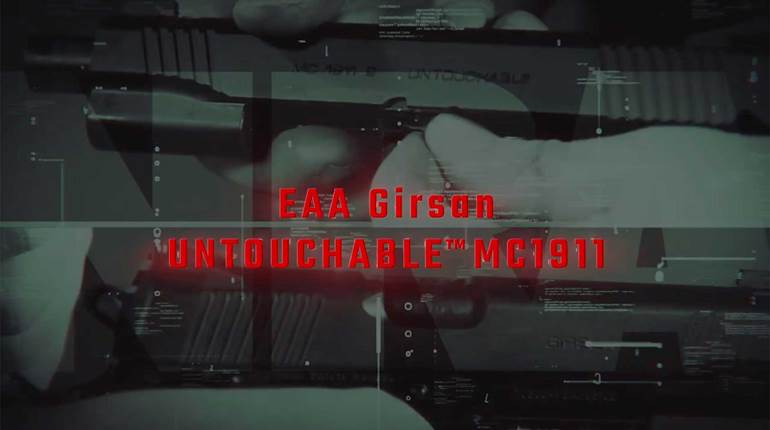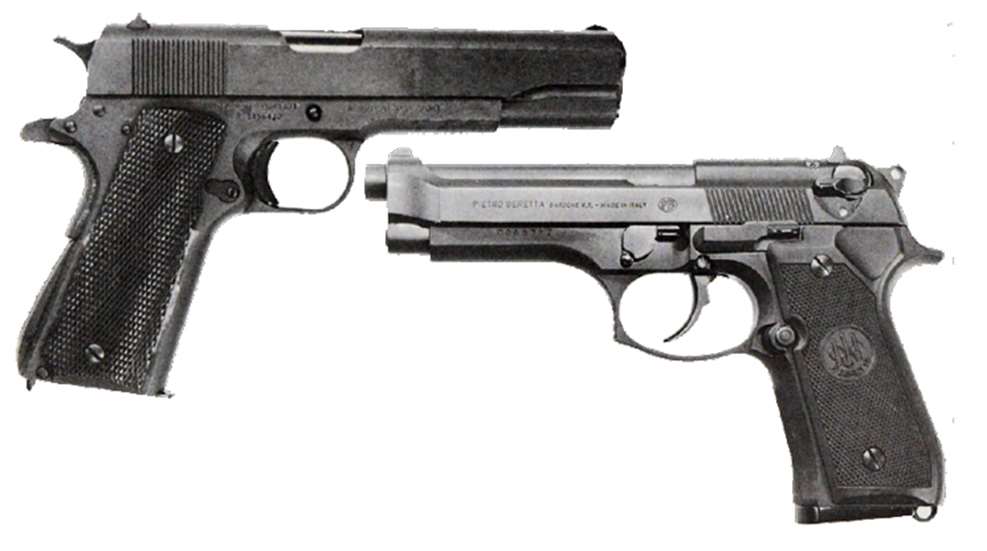
This article was first published in the August 1985 American Rifleman.
The M1911A1 is still the main handgun of the U.S. military and will remain so for some time to come.
Our latest approved, but as yet unissued, service pistol, Beretta's 92SB-F, has had much written about it of late, as has the M1911A1 that has seen its share of publicity for a longer period.
Reviewing some of the latest media accounts, we note, to our surprise, that the .45 Colt has been with us since Civil War days without major change; that the 92SB-F was used by the Italians in World Wars I and II, and carried by James Bond thereafter; that the .45 kicks like a mule but will consistently knock either mules or Moros off their feet; that the 9 mm has no recoil but will penetrate a tank; that the Beretta's size and weight are far less than those of the Colt, etc., etc. A few less surprising but, we hope, more accurate bits of information can be presented here to make comparison of the two guns easier.
It would seem superfluous to conduct actual comparison testing on the two. The M1911A1 is now only available used or in the modernized Series 80 civilian version, and for some time, 92SB-Fs, or 92Fs as the latest imports are marked, will be hard to obtain except by the Federal Government as M9s or as samples by police departments. Besides, both pistols have been tested by the military with thousands of rounds under all kinds of conditions, and both can be considered at least acceptable by any practical military standard. 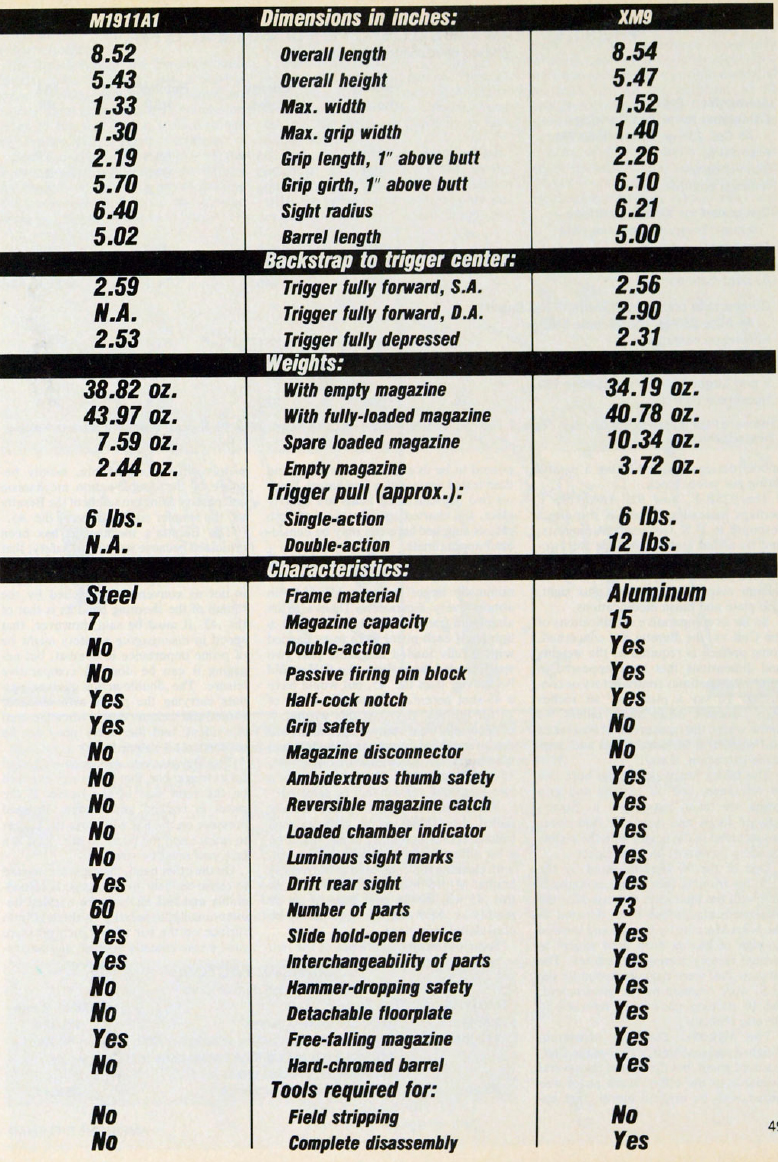
Nevertheless, they or their cartridges can be compared as to their histories, mechanical specifications, dimensions, weights, ballistics, logistics and, to an extent, both their political and psychological potentials.
Not much space is needed for the M1911A1's history. It was John Browning's design and, after several years of modifications, appeared in 1911. Fifteen years later it got an arched mainspring housing plus a few other niceties and became the M1911A1. Our government, but not our civilians, stopped buying it in 1945, but all have been using it ever since then.
The Beretta can be said to have been inspired by a combination of the .380 Model 1934 Beretta's full-length, open-slide, rowel hammer styling, a double-action mechanism and a pivoting breech locking block similar to that of Walther's famous P.38. 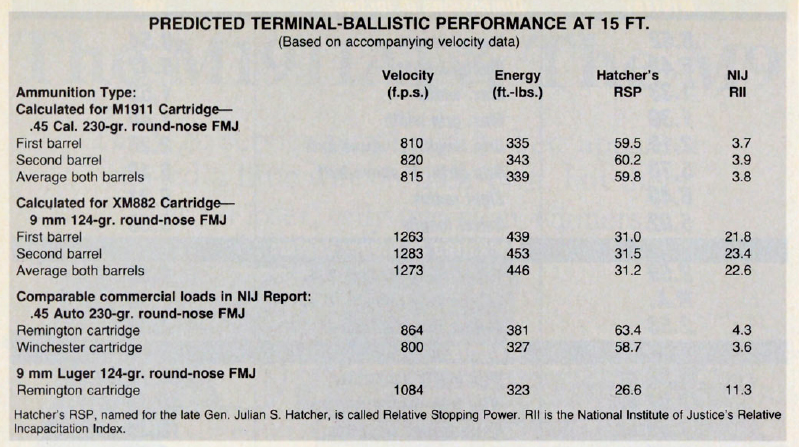
In the early 1950s, Beretta brought out the Model 1951 or 951 or Brigadier, as it was variously known. It had an eight shot 9 mm Parabellum magazine with its release catch in the butt, and was of the single-action type with a cross-bolt safety, but the Walther-type locking block was already in place.
By 1976, the double-action version of the 951 was out with a frame-mounted, up-and-down thumb safety and 15-round magazine. This was the Model 92. Two years later the 92 was called the 92S because the safety had been moved to the slide. By late 1979, for the U.S. Air Force tests, the 9251, with a reversible magazine catch button behind the trigger and an ambidextrous safety, had been devised. In 1982, the figure "1" was dropped and a "B" was added to the model designation, indicating a passive firing pin safety block.
The 92SB-F, now 92F (with the F perhaps indicating Final), is the direct response to U.S. Government requests, and its added features include the two-hand- hold trigger guard, side-to-side pierced lanyard loop, and beefed-up aluminum magazine floorplate plus sight, grip plate and finish modifications.
So far as comparative specifications of the Colt vs. the Beretta are concerned, some preface is required as the weights and dimensions that have appeared in print are sometimes contradictory or confusing. To say a pistol is "six inches high" doesn't mean much unless we know where the measurement was taken and whether it included sights and magazine extension, if any.
The tables herewith use the bore line as reference, and all lengths and grip girths are taken parallel to it. Sights, lanyard loops and magazine floorplates are included in the height with the pistols standing (inverted) on their sights.
One of the 10 Berettas used by the U.S. for training (not firing) in conjunction with the final tests was used for the measurements. It has been donated to the NRA Museum by Beretta and showed no sign of having been fired except in normal factory testing procedures. The 30 guns that were actually tested by the U.S. were retained by the government; the 10 training guns were returned to Beretta officials. 
The M1911A1 that was measured, weighed and test fired, a 1942-made Colt, is a used pistol, but the best of the several available to the NRA. Each pistol was tested with its original barrel, that appeared to be in excellent condition, and then tested again with a new barrel. Since no two manufactured items are exactly alike, the charted specifications of both pistols supplied here can only be considered approximate.
As can be seen from the accompanying table, the 92F is about the same as or is minimally larger than the M1911A1 in almost every dimension. Thanks to its aluminum frame material, however, it is lighter. If each pistol were to be carried with a fully loaded magazine plus two spare loaded magazines, the 92F would be heavier than the .45, but would have a 45-shot potential compared to that of 21 for the M1911A1. At this writing, it is uncertain what spare magazine pouch the government intends to make/buy and whether it will accommodate one or two 15-round magazines. Rumor has it that a two-magazine version will be selected.
When Bianchi's XM12 (commercially called the UM84) nylon ambidextrous holster comes into play, things might be a bit different, for it weighs only 8 ozs. with cleaning rod compared to the rod less leather M1916 holster at 11 ozs.; but, as the .45 will fit the new Bianchi rig as readily as the 9 mm, this can hardly be considered important.
Some of the characteristics of the two pistols differ considerably, mainly because of the double-action mechanism and passive firing pin safety of the Beretta vs. the simpler single-action of the .45.
The Beretta's mechanism has been criticized because its manual safety, that also serves to drop the hammer safely without recourse to touching the trigger, is not as conveniently reached by the thumb of the shooting hand as is that of the .45. It must be said, however, that speed in disengaging a safety might be of prime importance in combat, but engaging it can be done at comparative leisure. The double-action feature permits carrying the pistol with chamber loaded and hammer down, when the need is evident, and the safety need not be touched at all before firing.
The Beretta has also been criticized for its trigger bar that is partially exposed on the right side of the frame. If the pistol is cocked and loaded, forward pressure on the bar will cause the trigger to retract and the pistol to fire. That is a fact, and must be stressed.
On the other hand, the pressure needed to cause the sear to disengage is considerable and not likely to be exerted unintentionally, especially as there is little surface on the bar where such pressure can be conveniently applied, and no protuberances in the holster to complicate matters further.
Be that as it may, the Beretta would, theoretically, be a safer gun if the bar were shrouded. However, provided adequate training is offered, with attention given to the sear bar, it is hard to see the exposed bar as much of a threat. 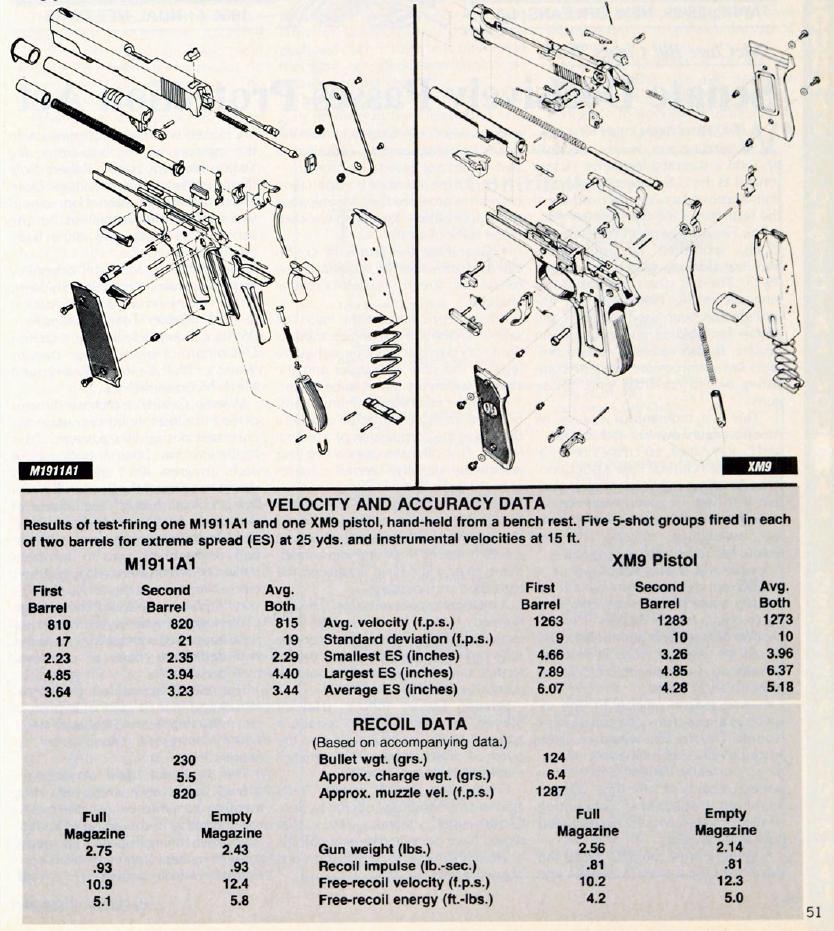
Some of those most critical of the above paradoxically censure the Beretta for being "too safe;" i.e., complicating the mechanism to include the passive firing pin block. These hard-bitten veterans admit that the M1911A1, lacking such a block, might fire if dropped with a round chambered, but say that one is not supposed to drop a gun in combat or in training. Colt, knowing something of combat arms, seems less convinced and has put the firing pin block in its new Series 80 pistols.
Some say the U.S. wanted an ambidextrous magazine release but, in the Beretta, got only a reversible catch. In truth the government required only operability by the right or left firing hand and this requirement was met. It is not hard, however, to imagine a scenario where a right-handed soldier picks up a left-handed comrade's pistol only to find he can't remove the magazine as he expected. Again, training should help and should take no longer with the M9 than the M1911A1.
A lot of time, relatively speaking, is spent training recruits to field-strip the M1911A1. Invariably, a few barrel bushing plugs magically fly out and away, and sometimes a recruit catches one in the face or even the eye. There is no chance of this with the M9. It is stripped by merely removing the magazine, pushing a button, turning a lever and slipping the slide/barrel unit off the frame.
The recoil spring is under little compression and it, its guide rod and the barrel can be easily and safety lifted from the slide—all in five seconds or less. Reassembly is equally simple, and troops will, in training, presumably be prohibited from completely disassembling the new pistol. This is just as well for, unlike the case of the M1911A1, standard shop tools are required for this thorny task.
A comment on the number of parts listed in the table is necessary. Some M1911A1s have 60, as listed, and this figure includes such things as two magazine floorplate pins and the floorplate. Some newer magazines eliminate the pins and combine the floorplate and magazine body, thus lowering the pistol's parts count. Everyone who counts parts seems to come up with a different total—the author takes the blame for the counts given.
Of more interest to some than the pistols themselves is the question of 9 mm vs. .45 U.S. military ammunition. It was possible to come up with figures on velocity from the two pistols, and these we give in the chart, based on the chronographing of only one brand of each ammunition. Other brands/lots must be expected to differ.
Undoubtedly in deference to our NATO allies, who measure only in the metric system and use most of their 9 mm ammunition in submachine guns, the terms of the official velocity requirement for the XM882 round may sound a little strange to American ears. It must propel its bullet at an average 385 ± 15 meters per second (1263 ± 45 f.p.s.) at a distance of 16 meters (about 53 ft.) from the muzzle of a test barrel that is 199 mm (7.8") long. That would indicate a muzzle velocity of about 1315 f.p.s. from the 7.8" test barrel. The velocity expected from the 5" pistol barrel is not stated in the ammunition specification, but interior ballistic calculations for the 9 mm round indicate that the 2.8" reduction in barrel length should result in a velocity loss of about 55 f.p.s., more or less according to the powder used. The expected muzzle velocity from the XM9 pistol would therefore be about 1260 f.p.s. In fact, our XM9 test pistol with this particular sample of M882 test ammunition averaged 1273 f.p.s. at 15 ft., corresponding to a muzzle velocity of about 1287 f.p.s.
The military specification for the .45 cal. M1911 Ball cartridge calls for an average velocity of 855 ± 25 f.p.s at 25.5 ft. from the muzzle of a 5" test barrel, corresponding to a muzzle velocity of about 865 f.p.s., or about 860 f.p.s. at 15 ft. Our M1911A1 test pistol, with this particular sample of Olin M 1911 ammunition, averaged 815 f.p.s. at 15 ft., corresponding to a muzzle velocity of about 820 f.p.s.
M882 ammunition, though officially type classified in April, 1985, has not as yet been produced in volume on government order. For our testing, some 9 mm XM882 ammunition (made by Olin to government specifications before the type classification) was obtained, together with some issue .45 M1911 ammunition also made by Olin. It is probable that service issue M882 ammunition, when available, will be of slightly lower velocity.
As charted, the velocity of the 9 mm is greater than that of the .45, as is the kinetic energy. If Hatcher's circa 1935 formula for relative stopping power (RSP) is used as the criterion, the 9 mm loses; if, however, the Relative Incapacitation Index (RII) numbers of the recent National Institute of Justice Report No. 100- 83 are considered for similar commercial loads, the 9 mm is the clear winner.
Specific data for the military .45 M 1911 and 9 mm M882 bullets are not given in the NIJ Report, but data are given for some similar round-nose FMJ bullets that are used in commercial ammunition by Winchester and Remington. Using the constants from the NIJ Report for the .45 cal. 230-gr. Winchester FMJ bullet and the 9 mm 124-gr. Remington bullet, together with the velocities obtained for the M1911 and M882 ammunition in our test guns, the RII of each load was calculated by the NIJ method. "Hatcher's RSP" for each load was also calculated for comparison.
Nostalgia and preconceived ideas aside, it is safe to say that professional ballisticians today are far more influenced by NIJ's RII ratings than by simple kinetic energy figures or RSP ratings, regardless of their usefulness in the past.
As comparisons, in the NIJ report, the Remington .44 Mag. 240-gr. JHP round at 1229 f.p.s. rated a 47.3; the S&W .38 Spl. 158 LRN at 708 f.p.s. rated 1.5.
All of this doesn't stop a .45 fan from rejecting the 9 mm out of hand or a 9 mm devotee from claiming that the .45 is good for nothing except museum display, but, regardless of which ballistic side one is on, it is impossible to deny that the 9 mm is a powerful and effective handgun cartridge.
In addition, it has the logistical advantage not only in that it is used by and presumably would be available through our NATO allies in combat, but also in that its bulk transportation weight is considerably less than that of the .45. Its cost, too, can be expected to be less than that of the .45, not because it's easier to make but because less material is used.
A new recruit of the U.S. Army, Navy, Marine Corps, Air Force or Coast Guard will probably be issued a rifle—if, indeed, he or she is issued any firearm at all. A good many today will find themselves loading and unloading software from computers rather than magazines from guns. Those who will ultimately carry pistols may find that they will have to learn the basics of the M1911/1911A1 .45 or the M9 9 mm or both.
Either can be the badge of authority and give one the confidence in a personal defense weapon that is the main role of a military sidearm. Neither can be considered a primary battle weapon.
If the U.S. Government will see to it that adequate training is given, and if the recruit accepts that training, either pistol will do and do well.
Which will do "best" may depend more on the user than the manufacturer, and the analogy of another common Government Issue item may be appropriate. In the field, choosing from a case of C-rations, one combatant might prefer Ham & Limas; another might favor Franks & Beans, but either will be most welcome if the combatant is hungry.
Acknowledgement The author wishes to thank Messrs. Mark Ness, William C. Davis, Jr., Birger Boggild, R. C. Miller, Jim Frigiola and Jim Cowgill for their generous assistance in the preparation of this report.













